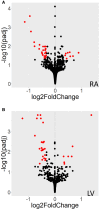The diabetic myocardial transcriptome reveals Erbb3 and Hspa2 as a novel biomarkers of incident heart failure
- PMID: 39180332
- PMCID: PMC11629987
- DOI: 10.1093/cvr/cvae181
The diabetic myocardial transcriptome reveals Erbb3 and Hspa2 as a novel biomarkers of incident heart failure
Abstract
Aims: Diabetes mellitus (DM) increases heart failure incidence and worsens prognosis, but its molecular basis is poorly defined in humans. We aimed to define the diabetic myocardial transcriptome and validate hits in their circulating protein form to define disease mechanisms and biomarkers.
Methods and results: RNA-sequencing data from the Genotype-Tissue Expression (GTEx) project was used to define differentially expressed genes (DEGs) in right atrial (RA) and left ventricular (LV) myocardium from people with vs. without DM (type 1 or 2). DEGs were validated as plasma proteins in the UK Biobank cohort, searching for directionally concordant differential expression. Validated plasma proteins were characterized in UK Biobank participants, irrespective of diabetes status, using cardiac magnetic resonance imaging, incident heart failure, and cardiovascular mortality. We found 32 and 32 DEGs associated with DM in the RA and LV, respectively, with no overlap between these. Plasma proteomic data were available for 12, with ERBB3, NRXN3, and HSPA2 (all LV hits) exhibiting directional concordance. Irrespective of DM status, lower circulating ERBB3 and higher HSPA2 were associated with impaired LV contractility and higher LV mass. Participants in the lowest quartile of circulating ERBB3 or highest quartile of circulating HSPA2 had increased incident heart failure and cardiovascular death vs. all other quartiles.
Conclusion: DM is characterized by lower Erbb3 and higher Hspa2 expression in the myocardium, with directionally concordant differences in their plasma protein concentration. These are associated with LV dysfunction, incident heart failure, and cardiovascular mortality.
Keywords: Diabetes; Erbb3; Heart failure; Hspa2; Myocardium; RNA-seq.
© The Author(s) 2024. Published by Oxford University Press on behalf of the European Society of Cardiology.
Conflict of interest statement
Conflict of interest: O.I.B. has received honoraria from Novartis. S.S. has received non-financial support, speaker's fees, and honoraria from AstraZeneca. R.A.A. has received institutional research grants and/or honoraria from Abbott Diabetes Care, AstraZeneca, Bayer, Boehringer Ingelheim, Eli Lilly, GlaxoSmithKline, Menarini Pharmaceuticals, Merck Sharp & Dohme, Novo Nordisk, and Roche. R.M.C. has received speaker's fees from Janssen Oncology. The remaining authors have nothing to disclose.
Figures



Comment in
-
Erbb3 and Hspa2, two novel predictors of heart failure in diabetic patients.Cardiovasc Res. 2024 Dec 4;120(15):1827-1829. doi: 10.1093/cvr/cvae220. Cardiovasc Res. 2024. PMID: 39450783 No abstract available.
References
-
- Saeedi P, Petersohn I, Salpea P, Malanda B, Karuranga S, Unwin N, Colagiuri S, Guariguata L, Motala AA, Ogurtsova K, Shaw JE, Bright D, Williams R. Global and regional diabetes prevalence estimates for 2019 and projections for 2030 and 2045: results from the International Diabetes Federation Diabetes Atlas, 9(th) edition. Diabetes Res Clin Pr 2019;157:107843. - PubMed
-
- McAllister DA, Read SH, Kerssens J, Livingstone S, McGurnaghan S, Jhund P, Petrie J, Sattar N, Fischbacher C, Kristensen SL, McMurray J, Colhoun HM, Wild SH. Incidence of hospitalization for heart failure and case-fatality among 3.25 million people with and without diabetes mellitus. Circulation 2018;138:2774–2786. - PMC - PubMed
-
- Cubbon RM, Adams B, Rajwani A, Mercer BN, Patel PA, Gherardi G, Gale CP, Batin PD, Ajjan R, Kearney L, Wheatcroft SB, Sapsford RJ, Witte KK, Kearney MT. Diabetes mellitus is associated with adverse prognosis in chronic heart failure of ischaemic and non-ischaemic aetiology. Diabetes Vasc Dis Res 2013;10:330–336. - PubMed
Publication types
MeSH terms
Substances
Grants and funding
LinkOut - more resources
Full Text Sources
Medical
Research Materials

